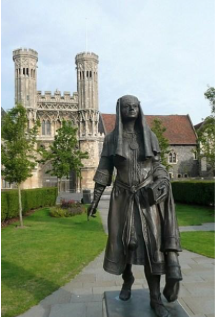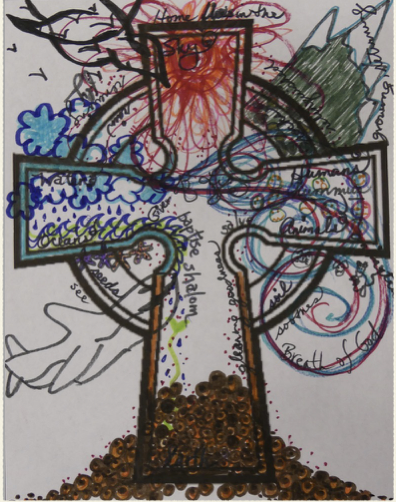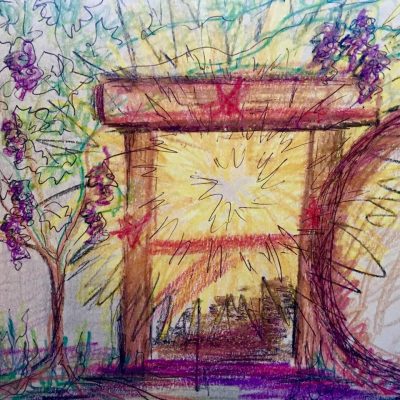As Mother’s Day approaches (at least here in the US, I will repost some of the prayers and posts about the feminine images of God in the Bible which inspired me to produce this video with Biblical verses and prayers interposed. Enjoy and please let me know what you think.
Biblical Maternal Images of God
compiled by Christine Sine
The music is Vesper: La Dimora Dell’Eternal by Lisa Peretti. (Used with permission.) not by Jeff Johnson as it says on the title page.
Today we thank God for the gift of mothers and mothering around the world.
As one whom a mother comforts, so I will comfort you – Isaiah 66:13. (RSV)
Gentle, patient God, thank you for your tender care.
Can a mother forget the baby at her breast
and have no compassion on the child she has borne?
Though she may forget,
I will not forget you! Isaiah 49:15 (NIV)
Loving, caring God thank you for your compassionate care.
But I have calmed and quieted myself,
I am like a weaned child with its mother;
like a weaned child I am content. Psalm 131:2
Protecting, embracing God thank you for your nurturing care.
How often have I longed to gather your children together, as a hen gathers her chicks under her wings… Matthew 23:37
Comforting, warmhearted God thank you for your gentle care.
God was like an eagle hovering over its nest,
overshadowing its young,
Then spreading its wings, lifting them into the air,
teaching them to fly. (Deuteronomy 32:11 The Message)
Ever present, sustaining God thank you for your enduring care
I have cared for you since you were born. Yes, I carried you before you were born. (Isaiah 46:3 NLT)
Sustaining, all sufficient God thank you for your satisfying care
I will be your God throughout your lifetime—
until your hair is white with age. I made you, and I will care for you. I will carry you along and save you. (Isaiah 46:4 NLT)
Faithful, providing God thank you for mothers and their love
Everlasting and eternal One, thank you for your mothering love.
Amen, Amen and Amen
This post is part of a series posted for Mother’s day that focuses on the mothering aspects of God. Here are the rest of the posts: Enjoy
Meditation Monday – Connecting to the Mother heart of God
Biblical Maternal Images of God by Shiao Chong
Maternal Images of God – a video and a prayer
Let’s Get Creative – Honouring Our Mothers
By Rev. Brenda Griffin Warren –
QUEEN BERTHA OF KENT
Our Life Can Influence Our Descendants
Queen Bertha of Kent’s Feast Day, May 1

Stained Glass of Queen Bertha of Kent
in St. Martin’s Church, Canterbury (photo by Clerk of Oxford)
Have we ever given much thought about how our ancestors lives have influenced ours and in turn how our lives might impact our descendants?
Queen Bertha of Kent, a 6th century royal, was influential in transforming the spiritual life of England as she brought renewed hope, new life, and light to a nation once rich in religious fervor. This nation that had earlier been influenced by both Roman and Celtic Christianity had declined into spiritual darkness over an almost 200 year period after the Romans left England in 407AD. Bertha’s Christian influence not only impacted England, but also infused her descendants who devotedly followed in her sacred path.
Bertha’s life and work was recorded in The Venerable Bede’s Ecclesiastical History of the English People. We also learn more about her in Gregory of Tours’ Historia Francorum (History of the Franks). He was a contemporary witness of this time period and he may have even met Bertha when she was in France.
So who was Bertha? She was a Frankish princess with quite a royal pedigree. She was born about 539AD to Charibert I, the Merovingian King of Paris and his first wife Ingoberga. Bertha was also the great-granddaughter of Clovis, the first king of the powerful Merovingian dynasty and his wife Clothilde who helped convert him to faith in Christ.
Bertha had been brought up near Tours, France and she was given in a political marriage to the pagan King Æthelberht of Kent, England. Bertha’s marriage was conditioned on her being allowed to practice her Christian faith. To ensure that this stipulation was met, she brought her chaplain, Bishop Liudhard with her to England.
It was during Bertha’s reign as Queen of Kent, when she was in her late fifties that Augustine was sent from Rome in 597 by Pope Gregory to evangelize Anglo-Saxon England. It is quite likely that the success of this mission is owed to several decades of Queen Bertha’s Christian influence that prepared the way for Augustine’s arrival in Kent. Pope Gregory wrote to Eulogius, the Eastern Church’s Patriarch of Alexandria, reporting that by Christmas 597, more than 10,000 English had been baptized in just a few short months. Four years later, in 601, Pope Gregory addressed a personal letter to Queen Bertha, in which he complimented her highly on her faith and knowledge of letters.
Years before Augustine’s arrival in Kent, Bertha longed for a private chapel in which she could pray and worship, so she restored a church in Canterbury which dated from the Roman occupation, dedicating it to St. Martin of Tours. The present-day St. Martin’s of Canterbury continues in the same building. It is the oldest church in the English-speaking world and is part of the Canterbury World Heritage site.
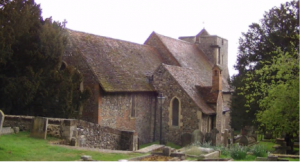
St. Martin’s Church, Canterbury that Queen Bertha restored
The fervent Christian faith of Queen Bertha was ardently passed on through her children, grandchildren, and great-grandchildren and quite likely further along her family tree. Her lineage is saturated with beloved Anglo-Saxon saints and royalty that influenced and transformed England, especially Northumbria and Kent. Queen Bertha’s descendants are closely connected with Hartlepool Abbey, Whitby Abbey, Ely Abbey, and even Faremoutiers Abbey in France. (to read further about her faith-filled descendants, you may follow this link: St. Bertha’s familial line)
Christian Queen Bertha’s willingness to leave her home in France on a not so easy nor pleasant journey by land and sea to marry the pagan Æthelberht of Kent whom she had never met nor laid eyes on was a defining moment that brought Christianity once again to England. Surely, it is our aspiration that like Queen Bertha, we too, are leaving a great spiritual legacy to our descendants to live into as they carry on the faith throughout the generations.
Our lives will continue to impact our descendants even when we are no longer living. May our spiritual influence passed on through family and friends leave plenty of hope, light, and love for those who follow behind us on the path to Christ, long after we have crossed over to the other side of the veil.
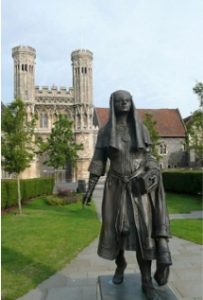
Statue of St. Bertha
Lady Wooten’s Gardens, Kent
By John Birch —
Thank you Lord
that when we are feeling
proud,
arrogant,
beyond reproach,
pleased with ourselves,
self-sufficient in all our ways,
you remind us
that for people like us
and all of humankind
you sent your Son into the world,
not to condemn us
but to save us from ourselves
before we stumble
fall and are hurt,
Thank you, Lord
that you embrace us
and enable us
to become the people
we were always meant to be,
children of a loving Father
blessing others through your love.
by Christine Sine
The Sunday after Easter Sunday is known as Holy Humour Sunday. Don’t miss out. Do you believe it’s acceptable to laugh and have fun in church? Sadly many of us don’t really seem to. We have grown up with an authoritarian God who is always serious and never playful. And now it’s time to change.
Evidently, for centuries in Eastern Orthodox, Catholic and Protestant countries, the week following Easter Sunday, was observed by the faithful as a day of joy and laughter with parties, picnics and tom foolery to celebrate Jesus’ resurrection. It came from the idea of some early church theologians that at Easter, God played a joke on the devil by raising Jesus from the dead. So on the Sunday after Easter, clergy and their congregations played practical jokes on each other, sang, danced and had fun.
I think Jesus loved to party. I suspect he also enjoyed a good laugh and now asks us to join the fun and plan our own Holy Humour Sunday. We might be too late for the week after Easter in Western Christian churches but in the Eastern Orthodox Church Easter Sunday was yesterday and so there is still time to get out and party, picnic and tell jokes. Or if you need more time to prepare than choose another Sunday between now and Pentecost.
The Easter laugh.
I only just learned about Holy Humour Sunday and today have spent time thinking about how to celebrate, and this is so in keeping with The Gift of Wonder that I couldn’t resist highlighting it here. This article Holy Humor Sunday: Make Them Laugh! is a great place to start getting ideas and maybe get some ideas for how to dress up, or down for the day. The Joyful Noiseletter is another place to look for ideas if you have trouble planning some fun times of your own, and the re: worship blogsite is a good place for liturgies if you are too fried after all the Easter activities to craft your own. However it shouldn’t be hard for us to come up with some fun ideas for church. Here are some suggestions that come to my mind:
Choose a fun liturgy
Re:worship blogsite is a great place to visit to add a more playful feel to the service. You might like to have some balloons and even party hats to hand out before the service for people to throw in the air. I particularly love this liturgy – complete with “holy humor breaks” in the service.
Joy is loose,
In the wiggles of the children,
The whispers of the youth,
The smiles of the adults.
We praise God for this glorious day,
Let the praise break forth
in the most unlikely places and in silly ways.
Joy and praise fills our hearts and in our songs
Let the laughter be deep,
for we are God’s people. (complete liturgy here)
Choose a word from your liturgy or a story from the scriptures to party around.
The liturgy that I put together for the Inhabit Conference a couple of years ago ends with the lines “joy bubbles up within” so Lilly Lewin (yep Freerange Friday Lilly) suggested that we blow bubbles at the end of the liturgy. It was a fun way to end the liturgy which talked about the awe and wonder of our neighbourhoods. If we had more time (and a bigger budget) we would have had people throughout the congregation blow bubbles at each other. Or at the end of the service you might like to give people noise makers and have them go out “making a joyful noise”.
If you want to plan an after service lunch to go with Holy Humour Sunday, a good story to use would be that of Jesus making breakfast for his friends on the beach after his resurrection. I can’t imagine this was a serious sit down type of meal. Plan a party with on the beach type games and round the campfire songs to help you celebrate the resurrection. Obviously this would be instead of the sermon, though maybe it should be.
Put out pens and paper before the service and suggest congregants colour or create their way through the sermon.
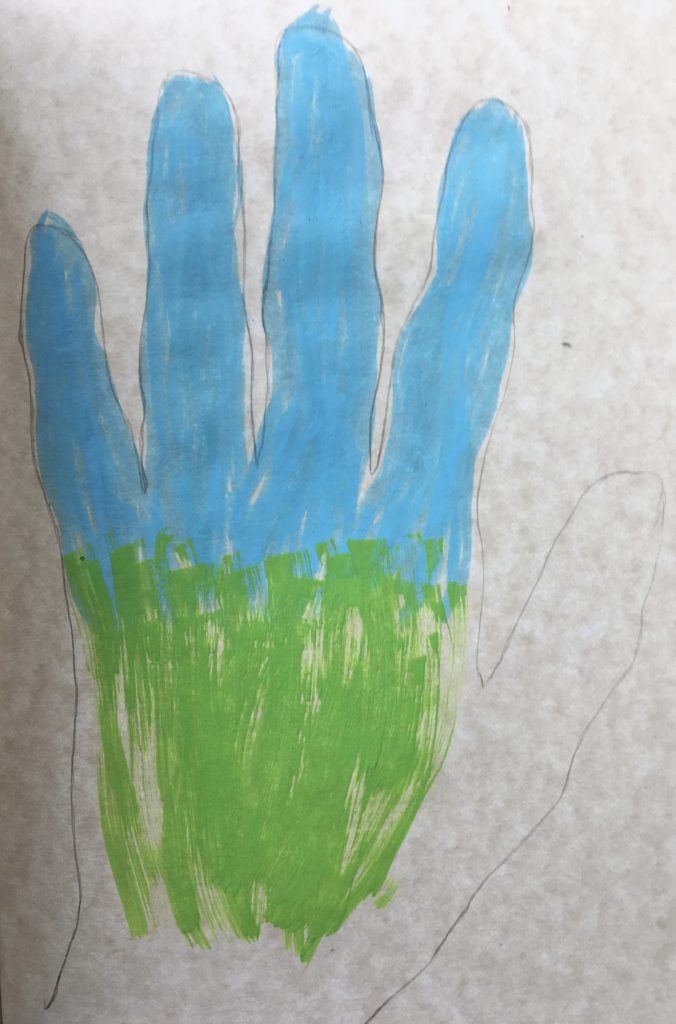
Shaped by the Hand of God – messiness OK
This is probably the simplest way to introduce some fun into the service. I have some templates that people can colour, but having blank sheets of paper for those who love to create is essential. I love to do this when I preach in a church and will often have time at the end of the service for people to share what they have drawn or painted. Giving people permission to bring fun into church in this way is something I think we should do not just on Holy Humour Sunday but every week.
Let the Kids Preach the Sermon and plan the party.
I think that our kids would come you with some very creative and fun ways to run church if we just gave them the chance to try. Holy Humour Sunday seems a good time to do this.
Introduce Each Part of the Service with a Joke
This suggestion from April Friet is a great one and the prayer she wrote for prayers for the people is wonderful. I suspect that most of us would have trouble coming up with enough jokes to go through the whole service but there are some good resources to help us with this too.
Find the Humour in the Scriptures
Instead of a sermon have people share the scripture verse or story that makes them laugh. If you decide to do this make sure that the kids are involved too. I suspect that they will find humour in place that we have never thought it possible.
What Ideas Do You have for Holy Humour Sunday?
As I mentioned at the beginning of this post, I was introduced to Holy Humour Sunday by someone who attended my seminar at the Inhabit conference this last weekend. We can all learn from each other. What ideas do you have for how we can celebrate Holy Humour Sunday?
by Lilly Lewin
Jesus’s death and then resurrection changes everything for his followers.
Even though Jesus warned them what was going to happen, that he would be handed over to the authorities and arrested and killed, I’m not sure they really believed him …they were still fighting over who would be greatest in the Kingdom.
They weren’t really prepared for the resurrection. Maybe you weren’t either.
The kingdom wasn’t coming the way they thought!
They thought they would have longer with Jesus!
They wished they’d taken better notes on all he said!
Why didn’t we listen more carefully?
So now what? What do we do now ?
Jesus appears to them.
Jesus isn’t dead!
Jesus is inviting them to think and live in a different way.
Resurrection is now a way to Live! And Easter is still happening!
Have we already forgotten?
Have we gotten busy and put away the Easter baskets and gone on to the next thing?
I love that the Eastern Orthodox Christians celebrate Easter this weekend! It gives us all a
chance to remember that the Resurrection happened and we get to celebrate again! I’m really excited because I spent Easter Sunday in bed with a sinus infection and had to cancel all the things I’d planned, even our thinplace worship gathering.
It’s great to have a second Sunday to experience Easter, especially those of us who work on Easter Sunday! People in ministry don’t always get to experience Easter in the midst of helping others experience the wonder. Or if we are working outside the church, we might not have felt it was Easter at all, or maybe life just happened and Easter didn’t.
The Good News is: It’s still Easter!
The Season of Easter, Eastertide…it’s truly not just one day, or even two, it
lasts until Pentecost which is June 9th this year.
So what would help you remember Easter in the coming days?
Here are some Ideas to help you “keep Easter” going!
1. Find a rock that will represent the stone that was in front of Jesus’s tomb. Each day hold it in your hand and remember that the stone is rolled away. death has been defeated. the whole earth is filled with resurrection. And remember, you have this life in you!
2. Clean up trash around the neighborhood or help a neighbor with yard work or a home repair. Bring resurrection and a bit of hope to your block.
3. Plant flowers. Inside or out. or Buy some potted bulbs and watch them bloom. Allow the growth to remind you of New Life!
4. Go on a picnic and lay on a blanket and look at the sky. Watch the clouds, pay attention to the sounds around you allow God to speak to you through nature…clouds, wind, sounds of the birds.
5. Visit a sick or shut friend, or give them a call. You could also make cards or cookies to mail to them if they are out of town or out of your neighborhood.
6. Take an hour and turn off all social media, and media in general, and take time to read the resurrection account from one of gospels. You might even use the Bible Gateway app and listen to the passage being read to you. Place yourself in the story as you read or listen. What do you notice? What surprises you? After you finish reading just sit with the passage. Allow the Holy Spirit to speak to you.
7. Pray daily for the needs of the World. Remembering the more than 300 people who died in Sri Lanka, Refugees around the world, the migrant families on our border. You can use a news app on your phone or even twitter to help you pray through the headlines and events of the day. Pray that people will have eyes to see the hope of God and that the power of Resurrection and the new life of Easter will be present in these places.
8. Join in an Orthodox Easter celebration this weekend or take time to learn more about Eastern Orthodox Easter practices.
9. Join The Awe and Wonder Easter Challenge with Christine. Planning ways to notice wonder and practice it daily.
10. And finally, was there something that you missed this Lent or this Easter day? Something that you might have wanted to do to celebrate the season or something you just didn’t get a chance to do, see, or experience? Plan a time to do this with yourself, your friends or your family. It could be something like making cookies or a special dessert, or sending an Easter card to a friend. Or it might be something bigger like hosting A Seder, or a foot washing, or praying the stations of the cross. Just google your local Catholic Church to find some stations to pray.
Just because the stores have moved on to the next holiday, doesn’t mean you have to do the same. Remember that the Easter season goes till June 9th, you’ve got lots of time. Keep celebrating and experiencing Easter and Keep sharing the Gift of New Life and Resurrection with the world!
 ©lillylewin and ©freerangeworship.com
©lillylewin and ©freerangeworship.com
Have you had your dose of awe and wonder today? Some are taking up the challenge though others tell me they just don’t have time for it. (how sad is that).
So to whet your appetite here are a couple of responses I have received this week.
Su Bowman sent in the photo above with the comment “I love the fragility of these sumptuous tulips, flouncing their glory in the sun”
And here is a beautiful poem by Carol Dixon.
Floral Tribute
Can flowers speak?
They spoke to me
in church at Passiontide.
From an earthen vase
on a table of light wood,
carved with the words:
‘Do this in remembrance of me’
I heard the purple irises’
spear-shaped petals
whispering of the sacrifice
of our dying Lord;
the crowding greenery
– like prickly privet bristles –
cry of his crown of thorns;
and, underneath them all,
in humble joy, the bursting,
golden daffodils’ resurrection
trumpets, radiantly announcing
that life lives on, through death.
© Carol Dixon
And my favorite from the week
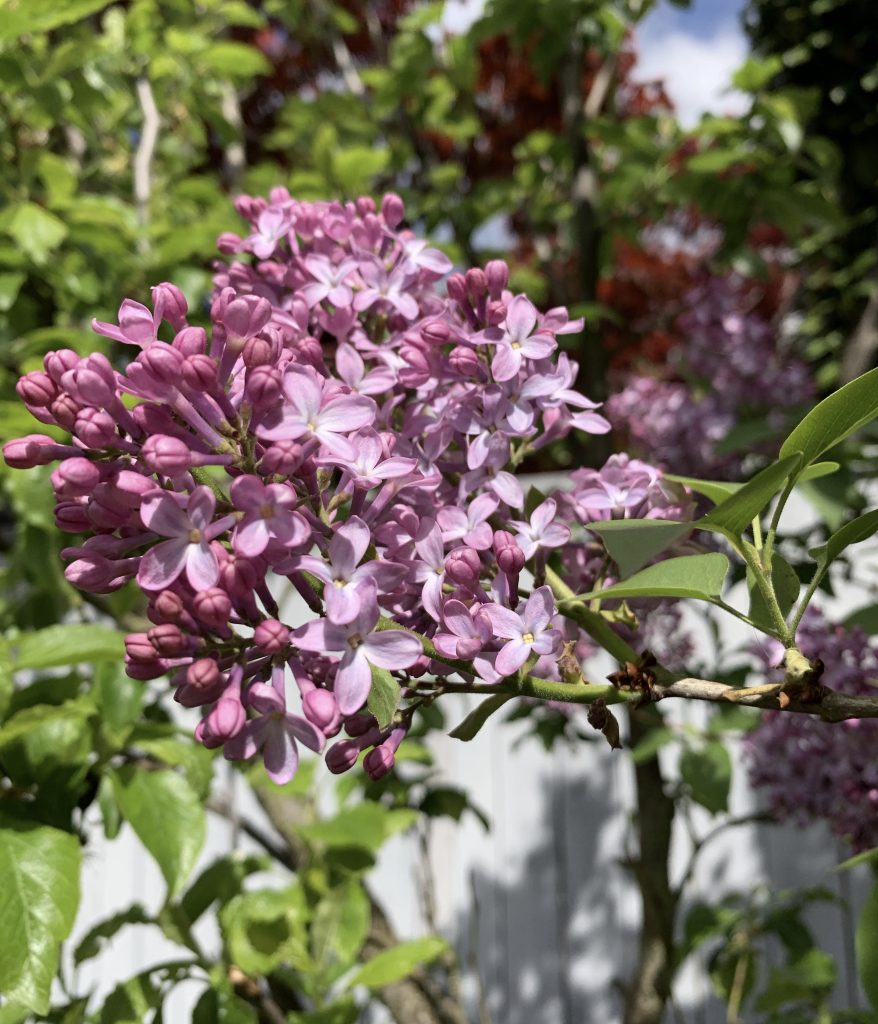
Lilac flowering
by Christine Sine
I am getting ready for the Inhabit conference this weekend. I am looking forward to seeing friends and making new ones. I am also looking forward to my workshop on awe and wonder. Some of it is familiar, the awe and wonder we anticipate when we get out into the beauty of nature. But I will also talk about a different type of awe and wonder. Many of the participants of this conference work with the houseless, the unemployed and the working poor. They struggle to make ends meet in challenging situations. Nature has little place in their environments yet there is still much to inspire us with awe.
How do we open ourselves to the awe and wonder of urban neighborhoods and houseless settlements under the freeway? Again Father Greg Boyle helps us gain the right perspective.
Standing in the margins with the broken reminds us not of our won superiority but of our own brokenness. Awe is the great leveler. The embrace of our own suffering helps us land on a spiritual intimacy with ourselves and others. For if we don’t welcome our own wounds we will be tempted to despise the wounded.
So how do we open ourselves to this type of awe?
First we need to slow down and take notice. Most of us hurry through our neighborhoods, intent on where we are going rather than where we are. Slowing down and giving ourselves permission to savor everything we see, hear and touch is an important step towards appreciating its awe. Suddenly we notice the gardens in a broken pavement and the beauty of dandelions in an abandoned lot. Then our eyes shift to the faces of strangers who pass us in the street. They too make us gasp in awe as we catch glimpses of the image of God in them.
Second we need to make space for silence. We don’t just hurry through life, we also go noisily through life, constantly making noise or listening to it. Taking time to enter the silence in which God can speak to us about where we live and what we need to take notice of is hard, yet necessary if we really want to see our surroundings as God does.
Third we need to take notice of the small and beautiful things. Awe can be triggered by an unexpected smile, a helping hand on the bus, graffiti on the wall. Giving ourselves permission to notice these things is a rare and precious gift.

Mural Beacon NY
Fourth we should seek out what gives us goosebumps. I recently walked around the township of Beacon New York. It is where Tom’s family live and I have always enjoyed walking the streets. However what I most look forward to are the murals – from the famous “man with no face” to the mermaid/Hudson River image, their beauty and the story they tell never ceases to inspire me. This year there were some new ones that caught my attention and filled me with awe.
Fifth see the world differently. Walk around your neighborhood with a houseless person, with someone from another culture or with a child. They will notice things you never see and have perspectives very different from your own. They will open your eyes to marvel at aspects of your community that you take for granted.
What Is Your response
I encourage you to take time this week to enter into the awe not just of God’s created world but of the communities in which you live as well. Take your camera and a companion with you. What do you notice? What inspires you? Take time to journal about your responses.
As an Amazon Associate, I receive a small amount for purchases made through appropriate links.
Thank you for supporting Godspace in this way.
When referencing or quoting Godspace Light, please be sure to include the Author (Christine Sine unless otherwise noted), the Title of the article or resource, the Source link where appropriate, and ©Godspacelight.com. Thank you!


